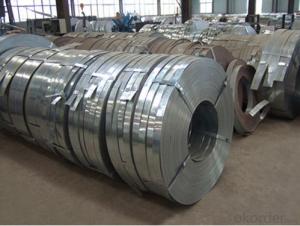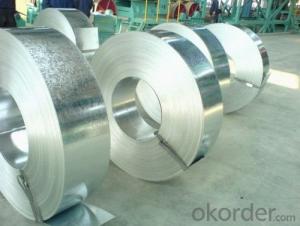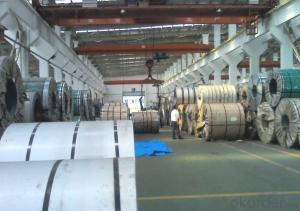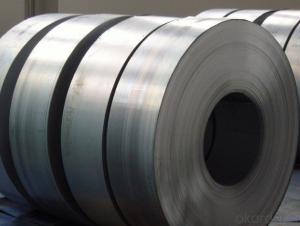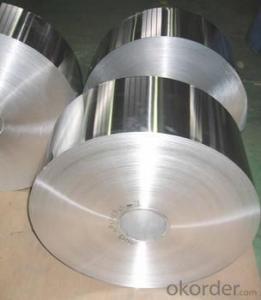Galvanized Steel Strip with High Quality-DX51D+Z 710*3.0mm
- Loading Port:
- China main port
- Payment Terms:
- TT OR LC
- Min Order Qty:
- 50 m.t
- Supply Capability:
- 10000 m.t/month
OKorder Service Pledge
OKorder Financial Service
You Might Also Like
Galvanized Steel Strip with High Quality-DX51D+Z 710*3.0mm
Product Description:
Specifications:
Thickness: 3.0mm
Width: 710mm
Material: DX51D+Z
ID: 508mm or 610mm
Spangle: Regular spangle or zero spangle
Surface treatment: chromated or no chromated; oiled or no oiled.
Advantages of Galvanized Steel Strip with High Quality-DX51D+Z 710*3.0mm:
1. Uniform coating;
2. Strong adhesion;
3. Strong corrosion resistant ability
Usage of Galvanized Steel Strip with High Quality-DX51D+Z 710*3.0mm:
1. Making pipes, like Greenhouse tubes, drinking water pipe, heating pipe, gas pipe and so on;
2. Used in automobile;
3. Used in construction;
4. Used in agriculture, fishery and so on.
FAQ of Galvanized Steel Strip with High Quality-DX51D+Z 710*3.0mm:
Q1: How soon can we receive the product after purchasement?
A1: Within three days of placing an order, we will begin production. The specific shipping date is dependent upon international and government factors, but is typically one month-two months.
Q2: How do you guarantee the quality of our products?
A2: We have established an advanced quality management system which conducts strict quality tests at every step, from raw materials to the final product. At the same time, we provide extensive follow-up service assurances as required.
Q3: The prices are invoicing on theoritical weight or on actual weight?
A3: We can do it in both manners, according to the customers' request.
Images of Galvanized Steel Strip with High Quality-DX51D+Z 710*3.0mm:
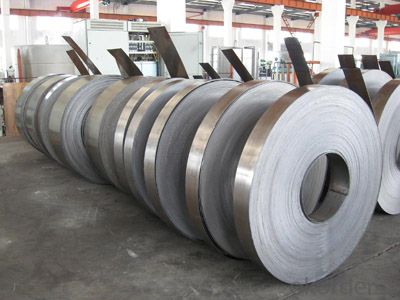
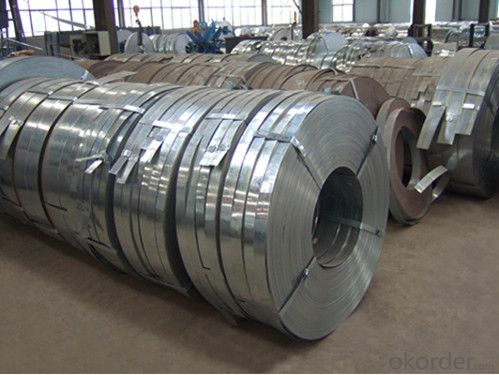
*If you would like to get our price, please kindly inform us the standard/material, specifications and quantity. Thank you very much for your attention.
- Q:Can steel strips be used in the production of watch cases?
- Watch cases can indeed be made using steel strips. The durability, strength, and corrosion resistance of steel make it a popular choice for watch cases. Steel strips can be effortlessly molded and shaped to achieve various designs, enabling a wide array of styles and sizes. Moreover, steel watch cases have a timeless and elegant appearance that is greatly sought after by numerous watch enthusiasts. In conclusion, steel strips are a suitable and frequently employed material for crafting watch cases.
- Q:Can steel strips be used in packaging or strapping applications?
- Yes, steel strips can be used in packaging or strapping applications. Steel strips are strong and durable, making them ideal for securing and bundling heavy or sharp-edged items during transportation or storage. They provide excellent strength and resistance to impact, making them suitable for securing goods that require extra protection. Steel strips also offer high tensioning capabilities, ensuring a secure and tight grip on packages or bundles.
- Q:Can steel strips be used in the manufacturing of power transmission components?
- Indeed, power transmission components can be manufactured using steel strips. These strips are widely utilized in the production of gears, shafts, couplings, and bearings for power transmission purposes. The utilization of steel strips provides exceptional strength and endurance, enabling them to endure heavy loads and high torque commonly encountered in power transmission applications. Furthermore, steel strips can be effortlessly shaped, machined, and heat-treated to meet the precise requirements of power transmission components. By incorporating steel strips in the manufacturing process of power transmission components, the resulting products possess the necessary mechanical properties to effectively transfer power and endure the demanding operational conditions across various industries, including automotive, aerospace, and manufacturing.
- Q:Can steel strips be used in food processing or pharmaceutical industries?
- No, steel strips are not suitable for use in food processing or pharmaceutical industries as they can contaminate the products with metallic particles and are not hygienic enough to meet the stringent requirements of these industries.
- Q:How are steel strips disposed of at the end of their life cycle?
- Steel strips are typically recycled at the end of their life cycle. They are collected and sent to recycling facilities where they are processed and transformed into new steel products, reducing the need for raw materials and minimizing waste.
- Q:How are steel strips processed for surface welding?
- To ensure a clean and smooth welding surface, steel strips undergo a series of steps. Initially, a thorough cleaning is performed using solvents or degreasers to eliminate dirt, grease, and rust. This step is vital as any impurities on the surface can adversely affect the weld's quality. After cleaning, the steel strips may go through pickling, which involves immersing them in an acid solution to eliminate scale or oxides formed during manufacturing. Pickling helps establish a chemically clean surface, devoid of impurities, which is crucial for achieving a robust and long-lasting weld. Following pickling, the steel strips often undergo surface grinding or sandblasting. Surface grinding entails removing a thin layer from the metal's surface to create a smooth and even finish. On the other hand, sandblasting employs high-pressure air or steam to propel abrasive particles onto the steel strips, effectively eliminating any remaining contaminants and providing a textured surface that enhances adhesion for the welding process. Once the steel strips have been thoroughly cleaned and prepared, they are ready for surface welding. This can be accomplished using various techniques, such as MIG (Metal Inert Gas) or TIG (Tungsten Inert Gas) welding. These methods involve creating an electric arc between the steel strips and a consumable electrode, which melts and fuses the metal together. The welding process necessitates precise control of heat, speed, and pressure to ensure a strong and uniform bond. In summary, the processing of steel strips for surface welding entails cleaning, pickling, and surface preparation steps to eliminate contaminants, enhance adhesion, and create an ideal welding surface. This guarantees a high-quality weld with exceptional strength and durability.
- Q:How are steel strips used in the manufacturing of agricultural machinery?
- Steel strips are commonly used in the manufacturing of agricultural machinery for various purposes such as reinforcement, structural support, and forming essential components like blades, frames, and chassis. The high tensile strength and durability of steel strips make them ideal for withstanding the demanding conditions and heavy loads experienced in agricultural operations. Additionally, steel strips can be easily shaped and welded, allowing manufacturers to customize and assemble the machinery efficiently.
- Q:Can steel strips be used in the production of hydraulic systems?
- Yes, steel strips can be used in the production of hydraulic systems. Steel is a commonly used material in the manufacturing of hydraulic systems due to its high strength and durability. Steel strips can be used to construct various components of a hydraulic system, such as cylinders, pistons, valves, and fittings. The use of steel strips ensures that these components can withstand the high pressures and forces associated with hydraulic systems. Additionally, steel is resistant to corrosion and can withstand extreme temperature variations, making it an ideal material for hydraulic applications.
- Q:How are steel strips tested for hardness?
- Steel strips are tested for hardness using a variety of methods, with the most common being the Rockwell hardness test and the Brinell hardness test. In the Rockwell hardness test, a diamond or tungsten carbide ball is pressed into the surface of the steel strip with a specific force. The depth of penetration is measured, and the hardness value is determined based on the difference in depth before and after the application of force. The Rockwell hardness test provides a quick and accurate measurement of the hardness of the steel strip. On the other hand, the Brinell hardness test involves pressing a hardened steel ball into the surface of the steel strip with a specific force. The diameter of the indentation is measured, and the hardness value is calculated based on the applied force and the size of the indentation. This method is suitable for testing the hardness of softer steel strips. Apart from these primary methods, there are also other hardness testing methods such as Vickers hardness test, Knoop hardness test, and Shore hardness test, which may be used depending on the specific requirements of the steel strip. These tests involve applying a specific load to the surface of the steel strip and measuring the indentation or the depth of penetration to determine the hardness value. Overall, the testing of steel strips for hardness is crucial to ensure their quality and suitability for specific applications. The chosen hardness testing method will depend on the type of steel strip and the desired level of accuracy required for the hardness measurement.
- Q:How do steel strips compare to other materials in terms of corrosion resistance?
- Steel strips generally have good corrosion resistance compared to many other materials, especially when they are coated or treated with protective layers such as galvanization. However, specific comparison to other materials would depend on the specific properties and coatings of those materials.
1. Manufacturer Overview |
|
|---|---|
| Location | |
| Year Established | |
| Annual Output Value | |
| Main Markets | |
| Company Certifications | |
2. Manufacturer Certificates |
|
|---|---|
| a) Certification Name | |
| Range | |
| Reference | |
| Validity Period | |
3. Manufacturer Capability |
|
|---|---|
| a)Trade Capacity | |
| Nearest Port | |
| Export Percentage | |
| No.of Employees in Trade Department | |
| Language Spoken: | |
| b)Factory Information | |
| Factory Size: | |
| No. of Production Lines | |
| Contract Manufacturing | |
| Product Price Range | |
Send your message to us
Galvanized Steel Strip with High Quality-DX51D+Z 710*3.0mm
- Loading Port:
- China main port
- Payment Terms:
- TT OR LC
- Min Order Qty:
- 50 m.t
- Supply Capability:
- 10000 m.t/month
OKorder Service Pledge
OKorder Financial Service
Similar products
New products
Hot products
Related keywords
